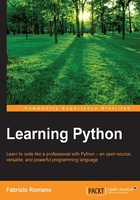
Setting up the environment
Before we talk about installing Python on your system, let me tell you about which Python version I'll be using in this book.
Python 2 versus Python 3 – the great debate
Python comes in two main versions—Python 2, which is the past—and Python 3, which is the present. The two versions, though very similar, are incompatible on some aspects.
In the real world, Python 2 is actually quite far from being the past. In short, even though Python 3 has been out since 2008, the transition phase is still far from being over. This is mostly due to the fact that Python 2 is widely used in the industry, and of course, companies aren't so keen on updating their systems just for the sake of updating, following the if it ain't broke, don't fix it philosophy. You can read all about the transition between the two versions on the Web.
Another issue that was hindering the transition is the availability of third-party libraries. Usually, a Python project relies on tens of external libraries, and of course, when you start a new project, you need to be sure that there is already a version 3 compatible library for any business requirement that may come up. If that's not the case, starting a brand new project in Python 3 means introducing a potential risk, which many companies are not happy to take.
At the time of writing, the majority of the most widely used libraries have been ported to Python 3, and it's quite safe to start a project in Python 3 for most cases. Many of the libraries have been rewritten so that they are compatible with both versions, mostly harnessing the power of the six (2 x 3) library, which helps introspecting and adapting the behavior according to the version used.
On my Linux box (Ubuntu 14.04), I have the following Python version:
>>> import sys >>> print(sys.version) 3.4.0 (default, Apr 11 2014, 13:05:11) [GCC 4.8.2]
So you can see that my Python version is 3.4.0. The preceding text is a little bit of Python code that I typed into my console. We'll talk about it in a moment.
All the examples in this book will be run using this Python version. Most of them will run also in Python 2 (I have version 2.7.6 installed as well), and those that won't will just require some minor adjustments to cater for the small incompatibilities between the two versions. Another reason behind this choice is that I think it's better to learn Python 3, and then, if you need to, learn the differences it has with Python 2, rather than going the other way around.
Don't worry about this version thing though: it's not that big an issue in practice.